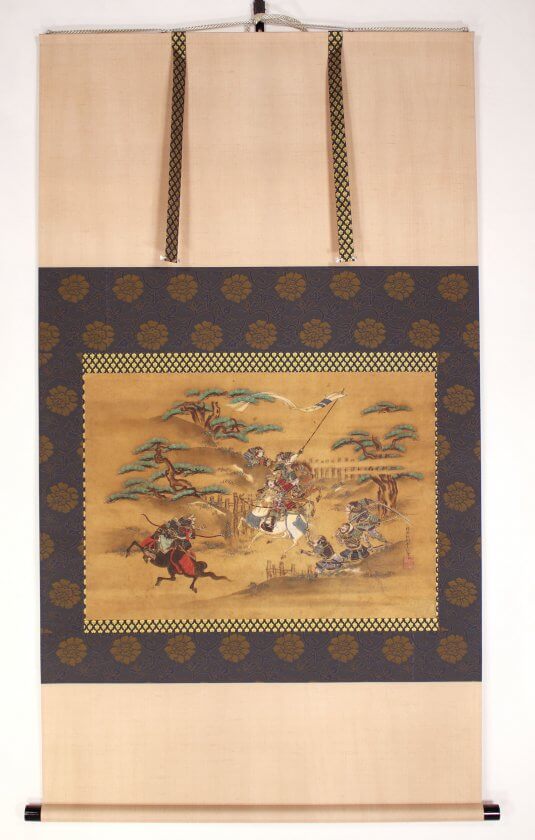Omote-uchi: Restoration of the Heavily Damaged Kakejiku

Contents
- 1 Long-standing Challenge for Kakejiku Mounters: Removal of Old Backing Paper
- 2 A Method Devised by Repair Specialists: Omote-uchi (Protective Temporary Lining)
- 3 Omote-uchi Movie
- 4 A Process to Re-establish Color to Losses in the Paint Layer: Hosai/Retouching (or Toning)
- 5 Preventive Measure against Creases: Ore-fuse (Reinforcing the Existing Creases from the Back of the Painting)
- 6 The Rest of the Mounting Process
- 7 Restoration Completed
- 8 Feedback from the Client
- 9 MOVIE
The older a kakejiku is, the more likely it will have some type of damage. Due to major damage such as dirt, break, and loss, an ancient kakejiku could be too fragile to be displayed. We receive many inquiries from both Japan and abroad for restoring the damaged kakejiku. Unless the kakejiku is simply beyond repair, what ART NOMURA can offer you is our best possible restoration so that your kakejiku can find its way back on display. This article features the special technique that we use during the restoration of a damaged kakejiku.
A gentleman who requested remounting the Battle Scene Kakejiku, which we are going to talk about today, is our long-time client from Europe. We have already worked together twice in the past. We are honored that he has put his trust in us!
Below is the kakejiku the client sent us for restoration this time.

You can see nasty tears/creases all over the painting. The pigment and Japanese paper will usually flake off from the tears during the process of removing the old backing paper from the artwork.



There are many areas where the paper has been lost. A part of Samurai warriors’ faces and bodies is lost as shown below.



The paper in the lower right-hand corner has greatly flaked off. It was unnoticeable at first because the backing paper applied to the artwork has darkened over time, but it will be noticeable after the replacement of backing paper, then result in an unnatural appearance.

Looking from the side will make it more apparent how severe these tears are.

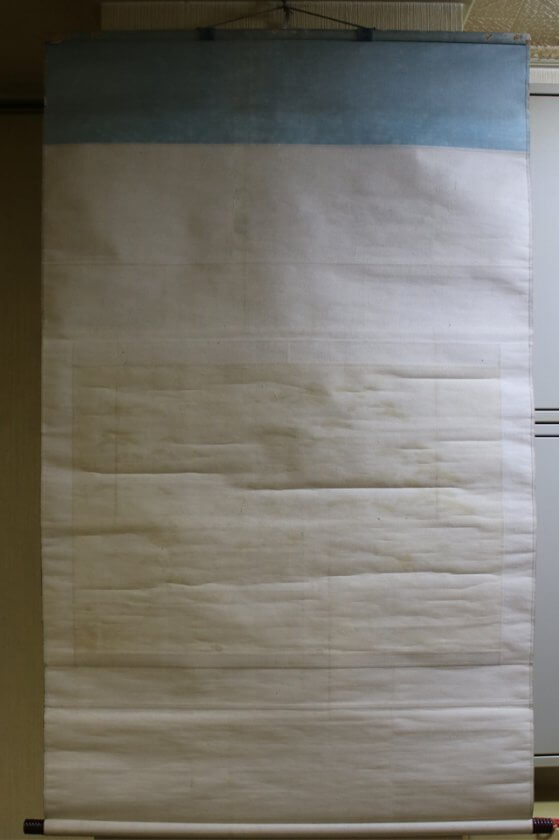
Long-standing Challenge for Kakejiku Mounters: Removal of Old Backing Paper

Removing old backing paper would be the hardest part of restoring the damaged kakejiku.
The backing paper is applied to the back of the artwork with paste. We can remove it smoothly if there is no significant damage to the artwork and the paste is not too strong.

However, if there is significant damage to the artwork or the paste is too strong, the artwork will come along with old backing paper when removing it.
What’s tricky about removing old backing paper is that we won’t know how tough it will be until we try.

A Method Devised by Repair Specialists: Omote-uchi (Protective Temporary Lining)

As mentioned above, the process of removing old backing paper has been a headache for kakejiku mounters. To solve this issue, a special method was devised in the 1980s by leading repair specialists who engage in the conservation of the important cultural property. The method is called “Omote-uchi” (Protective temporary lining in English).
Omote-uchi
It is an application of facing paper made of special Japanese paper (e.g. rayon) to the surface of the artwork for protection. This will be done before removing the old backing paper. The facing paper supports the artwork with enough holding force while the old backing paper is removed from the artwork. It prevents the artwork from coming off together with old backing paper and thus, minimizes the losses and misalignment of the artwork.

After successfully removing the old backing paper, we can move on to the next process of applying the new backing paper. The artwork won’t need protection any more at this point, so we remove the facing paper now. To remove the facing paper smoothly and not to damage the artwork, special paste is used as an adhesive for omote-uchi. The paste is of high-water solubility compared to the one for applying backing paper so that the facing paper will be removed easily when wet with a very small amount of water. This water will not affect the adhesive of the backing paper.
Omote-uchi Movie
The process of omote-uchi is of high difficulty level and time-consuming but it’s worth pursuing. Adding this process will remarkably improve the survival chance of the painting, especially while/after removing the old backing paper.
This innovative method (omote-uchi) was originally devised by repair specialists who restore the important cultural properties and National treasures, so it has been lesser known to the general (kakejiku/Fusuma/Byobu) mounters in Japan. As ART NOMURA gets many opportunities to restore old artworks, we did a literature search and conducted experiments. Practice makes perfect!
Below is the artwork after the facing paper is completely removed. We could keep the losses of pigment and Japanese paper minimum and successfully replace old backing paper with new backing paper. The white parts of the artwork are areas of originally missing so we will add colors to them. Let’s move on to the next process, “Hosai/Retouching”.

A Process to Re-establish Color to Losses in the Paint Layer: Hosai/Retouching (or Toning)
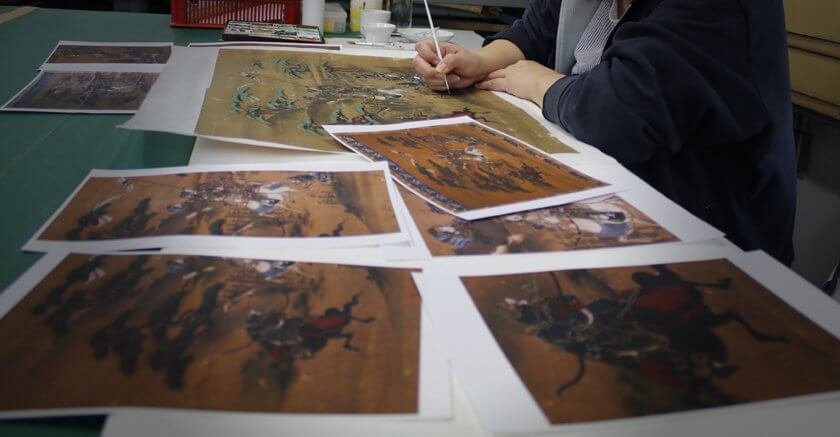
Firstly, we observe the artwork and imagine how an artist depicted it in the first place. Secondary, we prepare rough sketches for missing parts then finally start re-establishing colors.
Once this process starts, our staff will be glued to rough sketches and artwork.


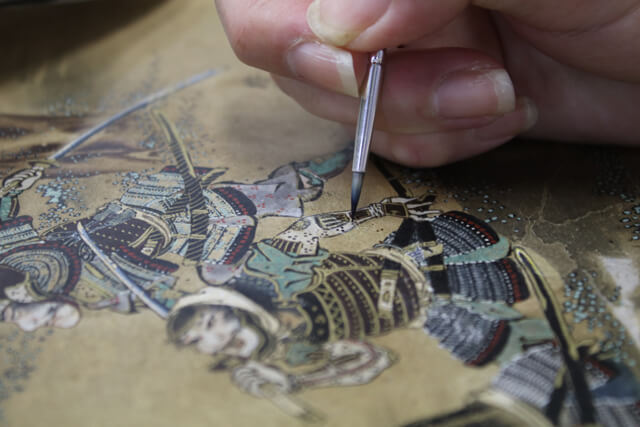
We use an extra thin brush for a depiction of Samurai Warrior, using an illuminated magnifier. Be careful! Even the slightest wobble can be a fatal mistake.

When doing Hosai (Retouching), our prime concerns are color match and the amount of water in the brush. For more control of the pigment, we use less water to dilute the pigment and dry the wet brush with the bottom-margin of the paper. This will stop color run, transfer, bleed and fade to the surroundings and keep the color where it should be. What’s not so good about it is we can’t pull much color from one brush stroke, so we need to build up the color gradually. Therefore, hosai/retouching can take days or even weeks to accomplish.

Hosai is completed. We filled in the gaps of missing parts with colors that look natural as the original artwork. Samurai worriers’ faces became more expressive after hosai, and make viewers feel a lot is going on in the battle scene.

Preventive Measure against Creases: Ore-fuse (Reinforcing the Existing Creases from the Back of the Painting)
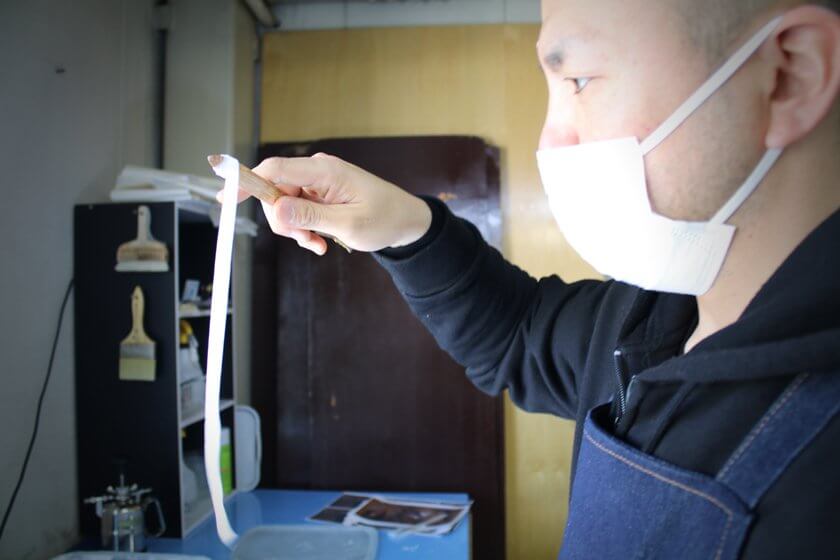
Where there are creases/tears are where Japanese paper fibers got weakened. If we won’t do anything about them, creases/tears would recur sooner or later. Creases/tears are lined with thin strips of Japanese paper for reinforcement like splint application. The thin strip of Japanese paper is called “ore-fuse.”

We light the artwork from below to find creases/tears and cracks, then apply “ore-fuse” to each damage, one by one. The older the kakejiku is, the more damage it tends to have so this process takes time too.



We are doing final checking, holding the artwork up to the natural sunlight.

The process of applying ore-fuse is finished. The number of ore-fuse pieces tells us how severely damaged the artwork had been.

The Rest of the Mounting Process
As for choosing mount fabrics, the client knew his way around fabrics. Yes, he’s been our long-time client! He told us his ideal mount fabrics in his mind with explanations and by showing a sample image. After discussing a lot to realize his ideal kakejiku, we have decided to go ahead with the following mount pattern:
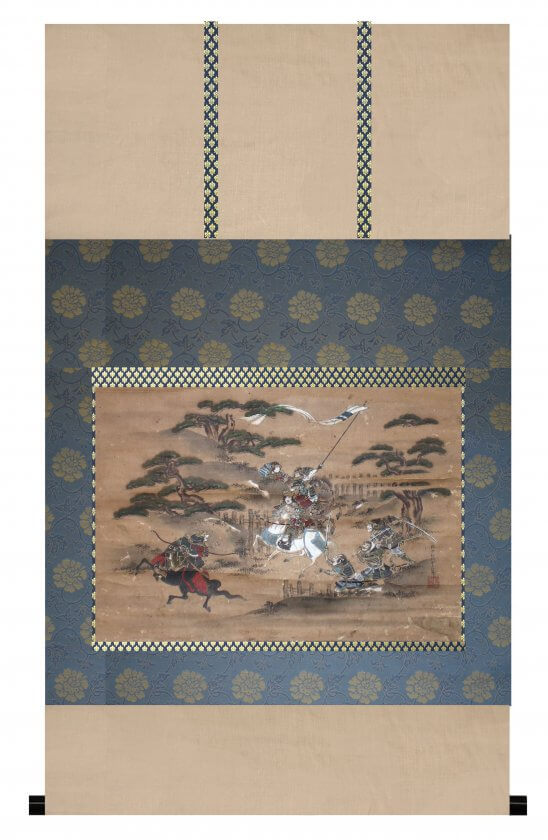
We prepared some more mount sample images other than the above. The client told us he had displayed and seen all the enlarged images on the TV screen, then made his final decision. We are very happy that our sample images were fully used! It is so rewarding.
The rest of the process after applying “ore-fuse” will be as follows:
Cut and Join (Tsuke-mawashi/Kiri-tsugi)
Apply the Second Backing Paper
Folding Over the Edge (Mimi-ori)
Apply Final Backing Paper
Finishing
Restoration Completed
The Battle Scene kakejiku is brought back to life. The gold patterns on ichimonji look like a samurai warrior’s family crest. It adds a masculine atmosphere to the painting. Also, the color of ichimonji is very dark with a clear navy with gold. This accentuates the painting and gives a good contrast to the rather soft chic colored nakamawashi with peony pattern. The ichimonji-otoshi gives a sharper look to the painting and works more effectively.
Restoration made it possible for viewers to feel more vibrant spirits of Samurai Warriors as they have regained their strength by Hosai/retouching. We have also done hosai to creases and fine cracks for a natural finish.
It was quite entertaining to attempt to visualize what the missing arm of the Samurai may have looked like. We made many sample images using Photoshop and discussed how to proceed it with our staff member.
Taking into account the artwork’s protection, we recommended that this hanging scroll should get a futomaki-style paulownia wooden storage box. Futomaki (wooden roller cramp) will give extra support to the restored artwork by increasing the diameter of a rolled scroll. A futomaki-style wooden box costs higher than an ordinary wooden box and we and the client have not talked about this option beforehand. However, we were sure it would help to ensure the longevity of the hanging scroll, in the long run, so we explained the above and asked the client to get one.
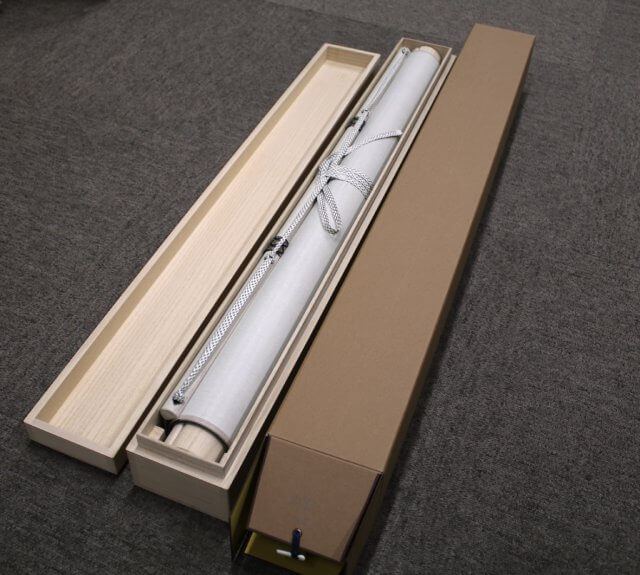
Feedback from the Client

After the hanging scroll made it home safely, we received great feedback and pictures from the happy client! We were informed by him that the scroll was going to be displayed at a special place in his home. So, we were looking forward to receiving these pictures.
Dear Yuuichi-san
The post brings back my kakejiku today. The package was huge then I expect so I wonder how it looks like when I opened. The scroll was big because of the Futomaki. The Futomaki is really a special tool made by an artist themself.When I start to scroll down the scroll and slowly the restore battle scene kakejiku opens his face……I was speechless.
The whole restorations process especially the repainting is absolutely amazing. Together with the wonderful fabric and the careful work of the remounting process gives this kakejiku a new life for the common years.
Yuuichi-san, my huge thank you, to you and all your craftsmen and Lady’s where make once more such a wonderful job.
ありがとございますゆういちさん
Thank you! The feedback means a lot to all of us at ART NOMURA that he took time to write and send the feedback. A few years ago, it was our professional goal to work with clients from abroad. Today, it has become such a normal part of our business. The story started with an inquiry from today’s client. It was an unforgettable experience, so we have a strong feeling for him. We are truly grateful for being able to work with him many times and receiving kind feedback for every work we do. We want to ensure we give all our clients the best service all of the time, so we constantly strive to improve our service even further.
Need help with your damaged kakejiku? Please do not hesitate to reach out to us.
MOVIE



